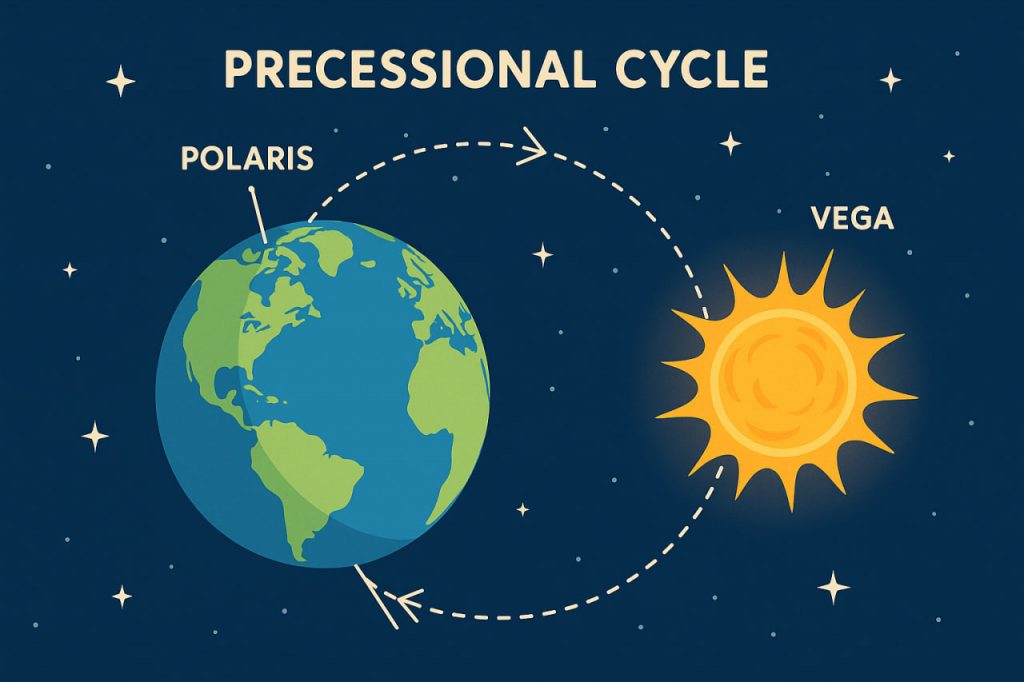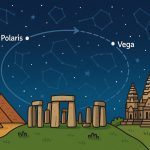Every 26,000 years, Earth completes a slow and graceful motion known as axial precession — a subtle “wobble” in its rotational axis that alters the orientation of the planet relative to the stars. This motion, though almost imperceptible in human lifetimes, has profound effects on Earth’s climate, seasons, and long-term astronomical cycles. The precessional cycle is one of the key elements of the Milankovitch cycles, which govern Earth’s glacial and interglacial rhythms over millennia.
What Is the Precessional Cycle?
The precessional cycle refers to the gradual shift in the direction Earth’s axis points in space. Currently, Earth’s axis is tilted at about 23.5°, giving rise to the seasons. However, this axis doesn’t remain fixed — it slowly traces a circular path, like the wobble of a spinning top.
One complete wobble takes approximately 25,772 years, meaning that over millennia, the North Star changes, and the timing of the seasons shifts relative to Earth’s orbit.
This phenomenon is caused by gravitational forces from the Sun, Moon, and planets, which tug on Earth’s equatorial bulge, causing a slow reorientation of the planet’s axis.
How Precession Changes Earth’s Orientation
Today, the North Pole points toward Polaris, but around 13,000 years from now, it will point toward the bright star Vega in the constellation Lyra. This gradual shift also means that the timing of solstices and equinoxes slowly drifts over time.
For example, about 12,000 years ago, the Northern Hemisphere experienced summer when Earth was closest to the Sun. Today, that alignment has reversed — summer occurs when Earth is farthest from the Sun, leading to milder seasons.
The Role of Precession in Climate Cycles
The precessional cycle is one component of the broader Milankovitch cycles, named after Serbian scientist Milutin Milankovitch, who showed how changes in Earth’s orbit and tilt influence long-term climate patterns. The three main cycles are:
- Eccentricity — changes in the shape of Earth’s orbit (about every 100,000 years).
- Obliquity — variations in the axial tilt (about every 41,000 years).
- Precession — the wobble of Earth’s axis (about every 26,000 years).
Precession alters the distribution of sunlight between the hemispheres, especially affecting the intensity of seasons. When the Northern Hemisphere points toward the Sun at perihelion (the closest point in Earth’s orbit), summers become hotter and winters colder — a combination that can accelerate the melting or growth of ice sheets.
Evidence from the Geological Record
Sediment cores, fossilized pollen, and Antarctic ice samples all show repeating cycles that match precession’s timing. These variations correspond to major ice age transitions over the last few million years. For instance, the end of the last Ice Age around 11,700 years ago coincided with a change in the precessional phase, increasing sunlight in the Northern Hemisphere during summer and melting the great ice sheets.
The Connection Between Precession and Ancient Astronomy
Long before scientists understood orbital mechanics, ancient civilizations noticed precessional changes in the stars.
- The Egyptians aligned temples to stars that slowly drifted over centuries.
- The Maya and Hindu calendars incorporated precessional cycles into cosmic timekeeping.
- Greek astronomer Hipparchus first scientifically documented precession around 130 BCE after comparing his star charts to those made 150 years earlier.
Future of the Precessional Cycle
In the distant future, precession will continue to shape Earth’s orientation and seasonal patterns. About 13,000 years from now, northern summers will occur when Earth is closest to the Sun, creating warmer, more extreme seasons. Meanwhile, southern climates may cool slightly, redistributing global weather systems once again.
Although precession operates over thousands of years, its cumulative effects are immense — influencing monsoon cycles, glaciations, and the stability of ecosystems.
Interesting Facts
- The precessional cycle causes the zodiac constellations to drift; the “astrological ages” (like the Age of Aquarius) are based on it.
- Around 3000 BCE, the North Star was Thuban, in the constellation Draco.
- The Moon’s gravitational pull accounts for nearly two-thirds of the precessional effect.
- Precession subtly changes the length of a tropical year, which is why calendars require adjustments like leap years.
- In 26,000 years, the night sky will look dramatically different to Earth’s observers.
Glossary
- Axial precession — the slow, conical movement of Earth’s rotational axis.
- Milankovitch cycles — long-term variations in Earth’s motion that affect climate.
- Perihelion — the point where Earth is closest to the Sun.
- Eccentricity — the measure of how elliptical Earth’s orbit is.
- Obliquity — the tilt of Earth’s axis relative to its orbital plane.


